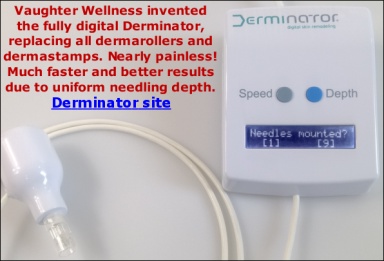In regards to dark under eye circles, is it effective to use the 0.20-mm roller and apply a Vitamin K product afterward (or wait a few days?)The circles under the eyes can have several reasons. The 3 most common ones are:
1) Increased pigmentation of the skin (brown colored dark circles), being quite common in darker skinned individuals. Or melasma, or sun spots.
2) Skin thinning. The underlying tissue such as veins and the orbicularis oculi muscle shine through as bluish, reddish or purplish tones. In addition, because there is not much fat between the skin and the muscle, the dark muscle absorbs the light and that makes the area darker.
3) Loss of fat in the area below the eye, making the area hollow and shadowy.
4) Shadows created by lax tissues, bags under the eyes etc.
Since dark circles are a hard to solve cosmetic problem you should see a cosmetic surgeon to evaluate your circles. I will give you some suggestions to ameliorate the causes mentioned above:
1) Bleaching creams such as hydroquinone or mild acid peels. Do not use Tri Luma since it contains a steroid and that might thin the skin even further. Tretinoin cream. Fillers.
2) The skin can be thickened by a dermaroller and the skin laxity improved. Using Retinoids may help thicken the skin as well. Using fillers such as Restylan or fat grafting will help. Make up concealers help.
3) Fillers such as Restylane or grafting your own fat tissue. This area is very tricky to use fillers on so choose your doctor carefully.
4) Plastic Surgery and/or fillers.
Whatever you decide, you should always use homemade vit. C serum on that area.
Vit. K supposedly breaks down hemosiderin but whether the circles are caused by hemosiderin deposits is not confirmed. You can try vit. K creams with a 0.20 or 0.25 mm roller.
]You cannot use a dermaroller directly under the eyes. Please read my reply #3:
https://http://forums.owndoc.com/dermarolling-microneedling/can-i-use-a-dermaroller-on-this-area-under-the-eye-(pic-included)/I have suffered from severe acne in my earlier teenage years; as a result, I can see red blotches under my skin on my face, probably as a result of inflammation and acne scars. Taking hot showers and having a bad diet (sugars and highly processed) also probably contributed to the problem. The red blotches are prevalent all around my face, but from far away you may not notice it. Adding to the that redness problem, I have broken capillaries around my nose and above my chin areaSo my QUESTION is: Will using the 1.50-mm roller in a proper manner and intervals reduce or diminish (completely over time?) the redness on my face by thickening the dermis and/or enhancing the healing of the red blotches?A dermaroller speeds up the skin turnover and that should help diminishing the red spots caused by acne. Whether they will diminish completely is impossible to know.
If those spots are due to hundreds of tiny broken capillaries then having vascular laser treatment would be better. Since you described the spots as "under the skin" it looks like they might indeed be capillaries.
Or should I save money for a series of Intense Pulse Light treatments?It is very difficult to judge because I do not know what is the cause of these blotches. The best is to make an appointment with someone who performs vascular laser treatments or a dermatologist and they should be able to tell you the cause of your redness.
Or Fraxel? But then, again, the derma roller theoretically should yield similar (but perhaps less dramatic results) as Fraxel.Fraxel works similarly to dermarolling. It makes tiny holes in the skin and our body will quickly fix the holes by filling it with new skin.
A vascular laser works differently. Capillaries and vessels transport red blood cells, containing hemoglobin. Certain Laser or IPL wavelengths are absorbed by hemoglobin. In the hemoglobin, this absorbed light energy is transformed to heat and that leads to the thermal destruction of the capillaries.
What ingredients should I be looking for in a product to help reduce the redness problem I have under my facial skin?If they are due to acne, start using homemade vit. C serum and a 0.5mm dermaroller.






